|
August
4
Leaving camp for the morning
drive, we were very sad that this was our last full day in
Botswana. If I didn’t have such a wonderful farm at Windchase, I
would be very tempted to run away from home and move to Botswana
to become a safari guide. Or better yet, a nature photographer -
perhaps one of the few professions even harder to make a living at
than horses . . .
We
drove through the beautiful forest of tall mopane trees – I
never figured out how they were able to grow so tall here, when
elsewhere they were all stunted from being eaten off by the
elephants. Zebras standing by the road glowed in the golden
morning light. A small herd of impala posed for a photo by a
termite mound. A pair of Egyptian Geese perched high in a tree;
one was standing on a hamerkop nest and the other sat on a high
branch. This was surprising, as we normally only saw them by the
water. We stopped to watch a splendid male giraffe as he browsed
the treetops in the early morning sunshine.
We
were on the hunt for lions. Gee found their tracks in the dusty
roadway, and we followed them for miles. We traversed Dead Tree
Island, zigzagging back and forth on the sandy roads to see which
way they had gone. In several places the road had long stretches
of deep sand which, the four-wheel-drive vehicle plowed through
with the engine racing. We searched through areas of tall reeds
and thick golden grasses; if there were lions lying down in there
we could have passed within yards and not seen them. We crossed
from island to island, fording water channels, some of them quite
deep. We seemed to have the delta to ourselves; there were no
other vehicle to be seen.
A
large herd of lechwe grazed undisturbed; surely they would not be
there if lions were near? But Gee told us that lions are patient
hunters – they would hide downwind of the antelope and wait for
them to come close. We watched a pair of young bucks wrestling in
mock-battle, honing their skills for the future. A herd of
elephants walked sedately by in the background.
|
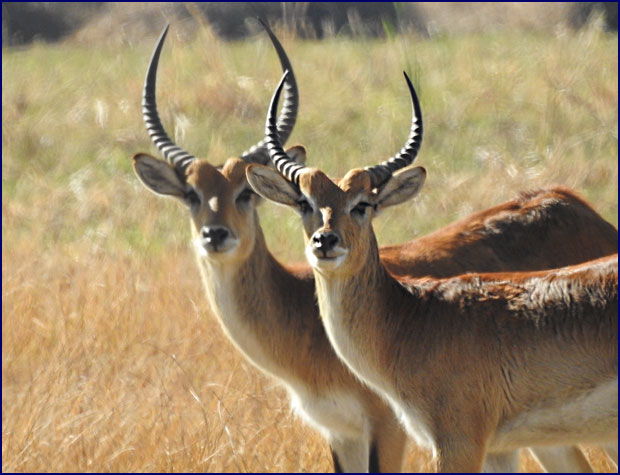
Red Lechwe
|
We
came to a large expanse of shallow water surrounding the
silver-grey trunks of dozens of dead trees. It was inhabited by a
wide array of waterfowl; white-faced, knob-billed and
yellow-billed ducks swam near the edge or sat on the shore, and a
hadeda ibis flew overhead. A lechwe bull stood poised against a
backdrop of bulrushes. A pale moon hung in the morning sky.
While driving along Gee spotted a
honey guide bird - I don’t know how he does it!
He told us that the honey guide bird is so named because it
leads honey badgers to bee hives; the badger opens the hive and
takes the honey, and the bird feeds on what is left. People also
follow this bird to finds hives; legend says that if you follow
one and take the honey you must always leave some for the bird -
if you don’t he will not forget, and next time he will lead you
to lions.
We stopped to watch some banded
mongoose as they scurried around searching for breakfast. A group
of mongoose is called a business,
and indeed they did seem to be intently busy. Sally got another
new bird, our LBJ for the day, a wood pipit. The lechwe were on
the move; they ran through the shallows, heads held close to the
ground, leaping and plunging through the water.
We
continued searching for the lions, crossing to ever remoter
islands as Gee tried to determine which way they had gone. At
about 9:45 we noticed a stationary vehicle in the distance; were
they looking at lions, I wondered? Sometimes checking out other
stopped vehicles can lead you to good animal sightings. But then I
saw someone out of the vehicle walking around - nobody would do
that if lions were about.
As we drew closer I could see four
people standing on a knoll near the vehicle, waving to us. We
waved back. But then I noticed that they were jumping up and down
and frantically waving their jackets in the air, and we realized
they were in distress and trying to flag us down.
The area was marshy and flooded,
so Gee stopped to figure out how we could get to the people
without getting stuck. They seemed to be getting more and more
agitated. We could see them desperately waving some sort of shiny
cloth, and could faintly hear them yelling - it sounded like they
were screaming HELP! There seemed to be a real emergency, and they
were frantic that we would leave without realizing that they
needed help. Was someone injured?
Gee drove to the closest point he
could get to them while staying on dry ground, about 300 yards
away. He got out and took off his boots and socks, and invited
Nick to go with him. Nick and George both eagerly scrambled out of
the land cruiser to join him, and they set out walking toward the
stranded travelers. Soon they were wading through knee-deep water;
Gee was barefoot but George and Nick still had their boots on. The
rest of us waited in the land cruiser, watching through
binoculars, slightly jealous of George and Nick – we would like
to have gone on the rescue mission too.
The people on the knoll seemed
very happy to see our guys, and some hugs were exchanged. It was
frustrating not knowing what was going on; it did not seem to be a
medical emergency, but appeared that their little pick-up truck
was stuck in the mud. A call from camp came over the land
cruiser’s radio; in Gee’s absence Jineen answered it and tried
to explain that we were in the midst of a rescue operation.
We got out of the land cruiser,
stretching our legs and going behind a bush for nature’s call.
While waiting I braided some reeds into a tiny grass rope,
laughingly saying it was in case we needed it to pull out the
truck. We were just getting ready to make tea when Gee came wading
back, bringing a woman and young boy with him. We all got in the
land cruiser, and having checked out the ground conditions while
walking, Gee was able to drive us across the flooded field to the
other vehicle.
The people in distress turned out
to be a family from the Netherlands; parents Jaco and Anna, and
their two boys, Oliver and Simon, ages 10 and 12. They had rented
a self-drive pick-up truck and were on an unguided camping safari
through the Okavango Delta. Very ambitious, since they had never
been to Africa before, and had never been camping. Nor,
apparently, had they ever driven a four-wheel drive vehicle.
Thinking that they could navigate by GPS, they had gotten the
little truck badly stuck in the mud. They had gotten stuck on
Saturday, and this was Tuesday - they had been out there for four
days! We were the
first people to come by in that time.
Anna
was in a dress, and all four of them wore rubber crocs
for footwear. The boys looked traumatized. The whole family was so
grateful to be rescued that they were hugging us, and Jaco was
openly crying. They had thought they were going to die out there!
And indeed, they well could have. They did have food and water
enough for a few more days, but they had no satellite phone, flare
gun, or any means of summoning help. Nobody at home would have
known to report them missing for another week. They had put
reflectors in the trees to try to make their location visible -
which might have worked had anyone actually been looking for them.
They had been there for three nights and four days, growing more
desperate with each passing hour.
The little white truck was
equipped with a pop-up tent on the roof for sleeping, but they
couldn’t use it because they were stuck in knee-deep water, and
there was no solid ground for the tent support posts. At night the
family slept in the truck, and during the day they sat on a knoll
formed from an old termite mound and tended the fire. They had to
wade through several feet of water to go back and forth to the
truck. During the day they sent the boys to gather firewood, which
may have had some inherent risks; after all, we
were out there because we were tracking
lions! Jaco and
one of the boys had tried to walk out to find help, but they had
been forced to turn back because their way was blocked by water
channels inhabited by hippos and crocodiles.
|
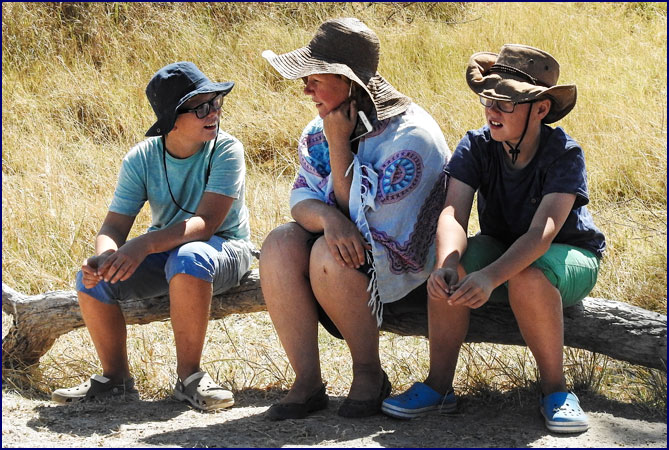
Anna, Oliver, and Simon |
Although
we had come to the rescue of the Dutch family, we had yet to
actually get them out. Gee, George and Nick started working on
getting their truck unstuck. They hooked it up to the land cruiser
with a long rope, but as Gee gunned the engine to pull them out
the rope immediately broke. (I told
him he should have used the grass rope I wove!) They tied the rope
back together and hooked it up again, and this time as Gee put the
gas pedal down the land cruiser got stuck. While all this was
going on, the rest of us had tea on the termite knoll with Anna
and the boys while watching the extrication attempts.
Gee produced a large jack, and by
lifting up the wheels of the land cruiser one at a time and
putting logs under them he got it unstuck. (It was evident he had
done this many times before!) Then with George and Nick’s help
he did the same with the stranded travelers’ truck, jacking up
the wheels one by one and placing branches under them for
traction. With Nick in the driver’s seat of the truck Gee tried
again to tow it out, but once more the land cruiser immediately
got stuck.
While
Gee, George and Nick jacked up the land cruiser again, Jineen,
Sally, Rosemary, Mary and I all gathered wood to put under the
wheels. Gee seemed surprised by the large loads we brought, but I
heard Nick say to him, ‘I told you, these are farm girls, they
know how to work - they are actually much tougher than me.’ Nick,
however, was in his element - he was enjoying the challenge of
getting the vehicles unstuck. To us this was all a great
adventure, but for the Dutch family who had been out there for
four days the whole experience was a terrifying ordeal, and they
must have been wondering if we would ever get them out. Gee told
them not to worry, that we would
get them out, and we could always radio for help if we needed
to.
The
guys got the land cruiser unstuck for the third time (or was it
the fourth?), and repositioned it onto better ground. They jacked
up the self-drive truck again and added more logs, and finally,
engines racing and mud flying, pulled it free amid much cheering.
The Dutch family cried and hugged us again, overjoyed. We took a
few photos of the family standing in front of the little truck,
which was well splattered with mud and dented from the jack.
|
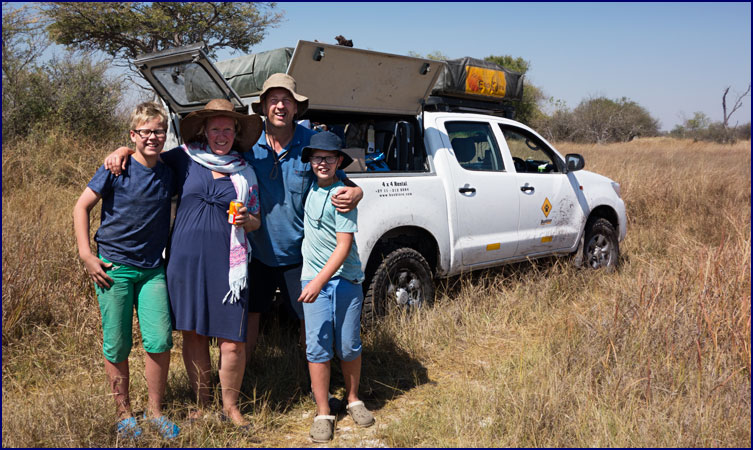
Jaco, Anna, Oliver,
and Simon |
But
we still had to find a way off the island. Gee set out driving,
looking for a dry route, with the Dutch family following. In
hindsight we should have gone back the way we had come in, but Gee
was afraid their truck wouldn’t make it through the marsh.
For a while we drove on solid ground and all was well, but
then we came to a stretch of road that was totally flooded - there
was nothing but standing water for over 100 yards. I thought it
looked pretty deep, but there were tire tracks through the water
where someone had crossed before, so Gee felt he could make it
through and then go scout for a drier route for the little truck.
He told the Dutch family to wait on the dry ground, and then he
eased the land cruiser into the water, following the tracks. At
first our 4WD vehicle hummed along through the water nicely, but
about halfway through it dropped into a deep rut and was promptly
stuck again. ‘This is very bad,’ said Gee.
‘Would a push help?’ I asked.
Before Gee could answer I had my shoes and socks off and was out
of the vehicle into the knee-deep water. The others followed suit.
The water was cold but not unpleasant, with the sandy dirt oozing
between our toes. Up close and personal with the Okavango Delta!
Gee seemed amazed that we girls were willing to get out and push,
but we were glad to show him that women are tougher than he
thought.
We managed to push the land
cruiser out of the rut, and it surged ahead for about twenty feet
before getting stuck again in an even deeper hole. We waded
forward, tripping over logs and stumbling into holes. The water
was up to our knees, and even deeper when we stepped in a rut.
Several times I tripped over a submerged log and almost went down.
Little fish were swimming around us. I asked Gee if there were
crocodiles - he answered, ‘Yyeesss!’ We thought he was
teasing, but we weren’t quite sure.
We couldn’t push the land cruiser out
this time, so we had to jack it up and put rubber mats (kept in
the vehicle for this purpose) and logs under two of the wheels.
Then we pushed again and the vehicle came free - and went about
ten feet before getting stuck again. Gee pointed out that there
were lots of logs in the ruts - we weren’t the first people to
get stuck here! The guys jacked the land cruiser up yet again,
while Jineen and I fished the rubber mats out of the mud and
dragged them forward to put under the wheels once more. Meanwhile
the Dutch family waited at the edge of the water, probably
thinking maybe they would perish out here after all.
We
went through this process several more times: Push the land
cruiser free, watch it go ten feet and get stuck again, wade
forward, jack it up and put logs under it, and push it free again.
Gee drove while Jineen, Sally, Rosemary, George, Nick, Mary and I
pushed (Mike stayed in the vehicle due to his artificial leg).
Finally we got past the deepest ruts and Gee was able to keep
going and get the land cruiser out of the water, with the rest of
us trudging after him.
Once we were all back on solid
ground, Gee waded back to drive the Dutch family’s truck out by
a different route, and Nick took the wheel of the land cruiser.
Being barefoot Jineen and I couldn’t traverse the thorny grass,
so Nick picked us up at the edge of the water. We then drove on to
meet Gee, who brought the little pick-up out by the route we had
originally gone in on, crossing the standing water and honking the
horn triumphantly while we all cheered. It had taken us four hours
to free the stranded travelers.
We invited the family back to the
camp for lunch. They followed us as we forded three more water
crossings, each one progressively deeper. The land cruiser had no
problem, but in the last crossing their little white truck was
nearly submerged, with a wave going up over its hood. When the
family finally made it across the last ford we all cheered, and I
think they were limp with relief.
On
the way back to camp we passed a pair of wattled cranes wading in
a pool. These elegant birds have become quite rare; Gee said there
are only about 1400 of them left in the world, mostly in the
Okavango Delta. Spraying for tsetse flies has interfered with
their eggs hatching, not unlike the problems with bald eagles and
DDT in the U.S.
|
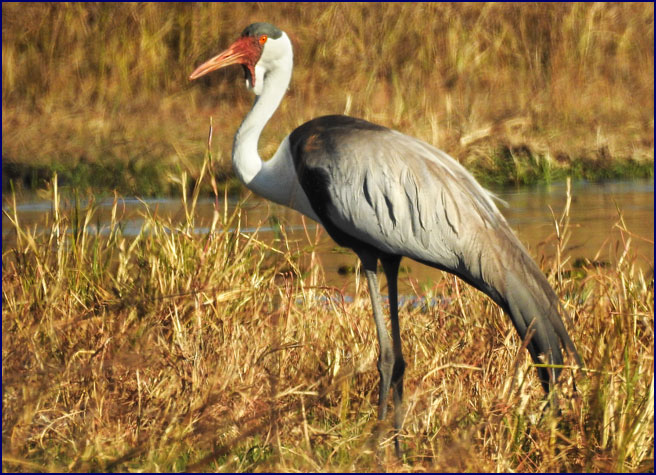
Wattled Crane
|
Crossing
an open grassy expanse, Gee spotted a serval crouched in the grass
about fifty feet from the road. This beautiful medium-sized cat
was well-camouflaged, with a combination of black stripes and
spots overlaying a tawny coat. The serval watched us warily, and
when he turned to leave we could see the broad stripes on the
backs of his large ears. This was another great spot by Gee; we
were constantly amazed at how he could find hidden animals and
birds while driving.
|
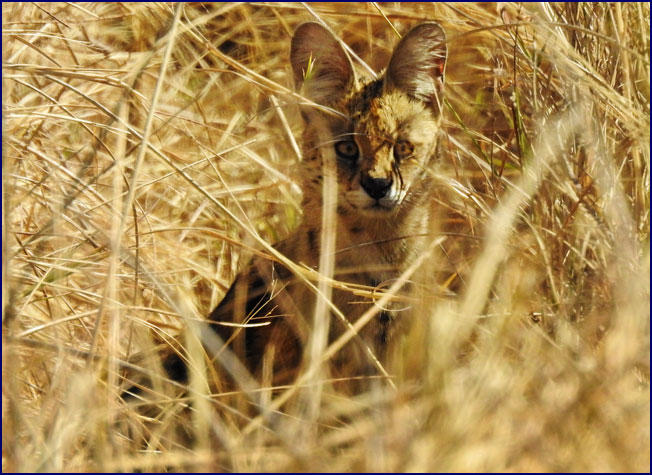
Serval |
We
crossed a rickety log bridge over a small river; the bridge
creaked and groaned as we drove slowly over it, the logs rolling
and shifting under our wheels alarmingly. A new bridge had been
built right beside it, constructed identically, but it was not yet
open for use.
When we arrived in camp Anna, Jaco,
Oliver and Simon looked around in awe - it must have seemed pretty
luxurious after four days of sleeping in their truck. Gee had
radioed ahead to let the guys know we would be having guests for
lunch, so two tables were set up. When Open greeted us holding a
platter of sugar-rimmed goblets of ice tea, Anna exclaimed,
‘This is paradise!’ And
she was right.
Lunch
was excellent, as usual, and our Dutch friends were happy to have
a good meal. They gave us a couple of bottles of wine they had in
their truck as a thank-you present. Squirrels visited us during
lunch, running up and down the trees near the table. A tiny dwarf
mongoose watched us inquisitively. We took much-needed bucket
showers, being especially grimy from pushing the land cruiser
through the swamp.
Our guests were due in Kasane the
following afternoon, and they had been planning to use the same
deep sandy tracks through the game reserves that we had come in
on. Gee talked them out of going on those difficult roads and
advised them instead to take the main (paved) road from Maun to
Kasane. Having used up their adventure quota, they were happy to
take the tamer route. Gee led them to the reserve gate so they
wouldn’t get lost, and Nick went along. When they came back Nick
was driving the land cruiser; afterwards he told us that driving
in that deep sand is much harder than it looks.
In
the afternoon we did a group photo with Gee and the guys; Nick set
his camera on a tripod and used the timer so he could get in the
picture too. Then we set out for our last afternoon game drive.
|
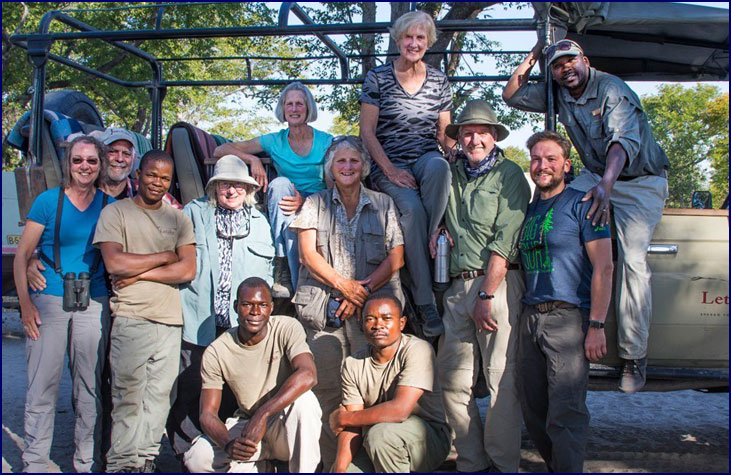
Our Group: Left
to right - Sally, Mike, Mosa, Mary, Open, Jineen, Phyllis,
KP, Rosemary, George, Nick, and Gee. |
We
drove from island to island, most of them separated by marshy
areas full of tall reeds. We met up with another Letaka vehicle
and Gee gave them the license plate we had found several days
earlier – they were the ones who had lost it. Jineen was only up
to 10 rollers for the day compared to 30 the previous day; were
they on the decline? I reminded Gee that a photo of zebras
drinking was still on my wish list; I hoped to get shots of their
stripes reflected in the water.
We passed a beautiful lagoon of
deep water, and then headed across a plain. Tsessebes grazed in
the sunshine. A secretary bird made its way through the grass and
an eagle soared overhead. We surprised a huge hippo in the brush
near the road; this was as close to one out of the water as we had
been. Gee pointed out that he was thin (for a hippo), and looked
like he must be old or unwell.
We
had seen a number of hamerkop nests, so I was happy when we came
across a waterhole with an actual hamerkop standing in it. This
interesting bird had a sturdy build, short legs, and a long strong
beak. He stood patiently in the shallow water; Gee said he was
looking for frogs. There was something about him that I found very
appealing.
|
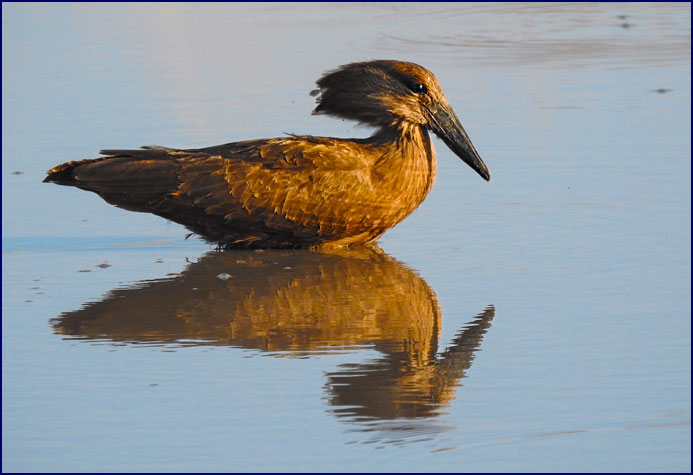
Hamerkop
|
It
takes six months for a pair of hamerkops to build a nest, and the
male and female work on it together. They will use any materials
they can find; things like clothes, garbage, and old shoes can
often be found in the nests. It is extremely bad luck to mess with
a hamerkop nest. Gee told a story about a boy in his village who
burned a hamerkop nest just for kicks - he soon got sick and
almost died. His family took him to a traditional doctor, who told
them that if you burn a hamerkop nest you will die. This witch
doctor was able to perform spells to cleanse him and saved his
life, but just barely. Gee also said that sometimes black mamba
snakes will lay their eggs in a hamerkop nest, and the birds will
raise them - I am not sure if this is fact or superstition.
We stopped by another watering
hole and a small herd of zebras approached; this might be my
chance to get that photo of a zebra drinking! They came and stood
by the water but apparently they were not thirsty; none of them
put their heads down to drink, but I did get a bit of zebra-stripe
reflection in the water. Gee told us that a group of zebras is
called a dazzle, because
when in motion their bold stripes can dazzle attacking lions.
More
zebras soon arrived. They stood quietly, scratching each other’s
withers and dozing in the late afternoon sun. We were content to
spend some time just watching the herd going about their business.
One of the zebras pawed the ground, sending up clouds of dust, and
then laid down and rolled in a sandy patch. Several others
followed suit, and soon three or four of them were rolling in the
dust together. A mother stood while her baby nursed, and I
realized my request had been met - technically this was
a zebra drinking!
Several
giraffes walked by in a stately manner. We learned that giraffes
have very keen eyesight at distances; they can see up to two
miles, but they don’t see as well up close. Only the strongest
males get to breed, but the other males are allowed to stay in the
group as long as they don’t challenge the herd leader.
The
sun was getting low in the sky when we finally moved on. We passed
a single male wildebeest; Gee explained that the dominant bull
will stay behind and defend his territory from other males while
the females of his herd roam searching for better grazing. The
bull is often thin, because he spends so much time patrolling that
he does not have time to graze enough. Tsessebes share this trait
as well.
A
hyena was sleeping right out in the open, stretched out flat on
his side on a low mound. He raised his head and gazed at us
sleepily when we drew near. A few hundred yards away another
hyena, perhaps his mate, was napping in a similar position.
It was the most brilliant sunset
we’d had yet. The sky was turning vivid shades of orange and
magenta, and we could see a few wisps of clouds accenting the
evening sky, the first we had seen on the whole trip. A pair of
ibis flew across the sunset. Darkness
crept slowly over the land.
Back
at camp, we sat around the fire and drank the wine the
Dutch family had given us.
Mosa announced dinner - sadly our last one. I stood outside the
tent for a long while before going to bed, soaking in the African
night sky with its glittering array of stars, and listening to the
sounds of the bush.
|